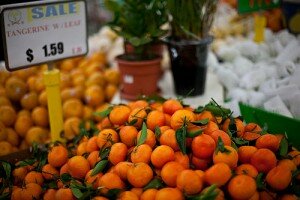 Locally made or locally produced may not always mean what you think. In recent years, as larger corporations have “caught on” to the idea that purchasing local products may actually be more cost-efficient (it’s cheaper to buy the corn for the Kansas Wal-Mart in Kansas than have it shipped from somewhere else), buying local has become more complex.
Locally made or locally produced may not always mean what you think. In recent years, as larger corporations have “caught on” to the idea that purchasing local products may actually be more cost-efficient (it’s cheaper to buy the corn for the Kansas Wal-Mart in Kansas than have it shipped from somewhere else), buying local has become more complex.
In a , Miguel Bustillo and David Kesmodel explain, “The lack of a federal standard or any consensus on what qualifies as ‘local’ food leaves grocers a lot of leeway in their marketing. At most large retailers, fruits and vegetables harvested hundreds of miles away can be touted as locally grown.”
How does this marketing scheme affect local producers? “Such loose definitions have sparked criticism from small farmers and organic-food advocates that the chains are merely adjusting their marketing to capitalize on the latest food trend, rather than making real changes in their procurement practices.” In other words, look carefully to find out whether or not what you are purchasing is actually locally produced.
In Omaha, that’s easy. Earlier this year, the reported that certain grocery stores have renewed their commitment to carry Nebraska products. As it turns out, stores like Hy-Vee and Whole Foods now carry so much Nebraska-made food that shoppers could go weeks eating exclusively Nebraska-made food without stopping at a specialty store.
From milk to cheese to granola to beef, pork, chicken, bread, beer, popcorn, nut butter, produce, condiments, and more, the expanse of food entrepreneurship in Nebraska has allowed for more makers and therefore, more food for supermarkets to purchase. The article even reveals that Whole Foods offers loans to local producers for expansion and expenses, usually around $10,000 to $100,000.
If you’re in Omaha, you can stop by the Hy-Vee at 178th and Pacific Streets to browse the several hundred local items that health market manager Vicki Millian attempts to stock. “We don’t say no very often because there are just a lot of good products made here,” she said. “We want to help support the local businesses. It always comes back, and it’s good for everybody.”
So what are the criteria for ensuring that you’re buying Nebraska-grown, locally manufactured products—food or otherwise? A good rule of thumb is to ask the store manager where it comes from. Chances are, if it’s locally produced, they’ll be familiar with the origins.
As explains, when you buy local, you’re ensuring that money stays in the community, which is important to the future of not only that grocery store, but the manufacturers around it.
Don’t let the price of a product that’s locally made vs. produced overseas scare you away. “The difference falls away once you consider the increase in local employment as well as the relationships that grow when people buy from people that they know,” the Time article continues. Yes, the product may be fifty cents more, but the long-term community benefits far outweigh that.
Your purchase is important to Nebraska, and the choices you make do have an impact. Questions? Comments? Want to learn more? Leave them in the section below, anytime!
—
photo credit: via
 Official Nebraska Government Website
Official Nebraska Government Website
